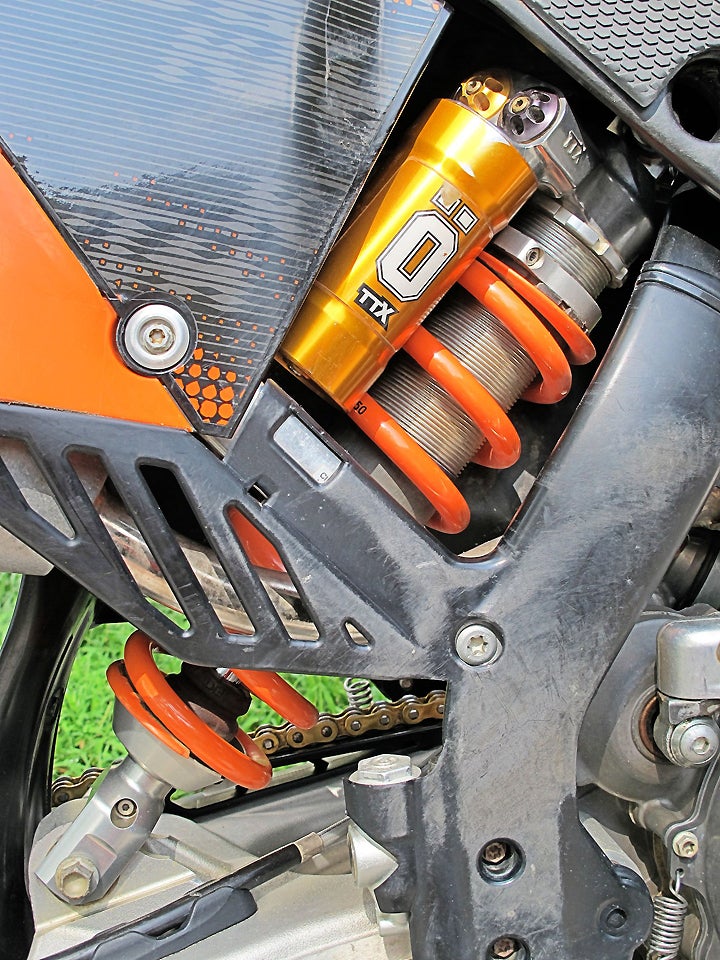
As I’ve continued to improve my off-road riding skills, I’ve learned what investing in quality suspension components such as an Öhlins TTX44 shock and TTX22 fork cartridges could do to help my KTM 250,XC-W even better.
Every dirt bike I’ve owned since has gotten a suspension rebuild of some sort. There’s no going back after having custom-tailored valving. I had already installed softer springs on the KTM to suit 150-lb. body weight and the relatively slow/tight/technical riding I do most. And I had its damping (front and rear) re-valved twice, the second time with Race Tech Gold Valves. Alas, despite expert tuning and upgraded parts, the Katoom’s WP suspension still lacked the plush-yet-controlled feel of the Showa/Race Tech suspenders on my old CRF250R. I was ready to go to the next level.
Having experienced the quantum leap in performance produced by Öhlins components on several street bikes, I was eager to see how they did in the dirt. I hadn’t already done so because the retail price of such a kit is quite daunting, especially after having spent many hundreds on those two prior re-valves. A new Öhlins TTX44 shock for my bike costs over $1100 without a spring. New TTX fork guts, also sans springs and other necessary bits, cost nearly $1300. (As expensive as the latter are, they’re cheap compared to the $3k+ price of a set of basic Öhlins forks.) I found a cheaper way to go.
A used KTM dual-sport bike I recently acquired came with a Öhlins TTX44 shock installed and the OEM unit included in a box of extras. Knowing I’d appreciate the special piece more on my pure-dirt mount, I put the original shock back on the dual-sport (after the obligatory re-valve and spring replacement) and transferred the Öhlins TTX44 to my 250XC-W. No re-valving of the Öhlins TTX44 was necessary because of a magic adjustment feature that I’ll discuss more later. Öhlins springs have a slightly smaller internal diameter than the coils from WP, so they’re only swappable in one direction, which was all I needed. I transferred the 250’s existing spring to the Öhlins shock, and set the too-stiff-for-me Öhlins spring aside. So, for no additional cash, the rear was done.
Serendipitously, a pair of TTX22 fork cartridges appeared soon thereafter on Craigslist for a mere $450, supposedly with only eight hours on them. I’d have to get new springs ($110 from Factory Connection, $150 from Öhlins) and a few other parts ($140 from my mechanic) to adapt the gas-charged cartridges to my (originally open-cartridge) forks. And the new cartridges would have to be re-valved ($100) because they’d been set up for a motocross bike with a heavier rider. Even with installation labor and oil, the total pre-tax cost was just under $900. Obviously, that’s still a lot of money, and almost twice what I’d spent to have Gold Valves installed at both ends. But, with some rationalizing, a total of $900 for an Öhlins TTX44 shock and a TTX22 cartridge kit to set up the front and rear seemed like a sweet deal.
So was it?
Definitely! The already pretty good 250 was transformed. Its rear end, with KTM’s linkage-less PDS configuration, had been prone to kick up over small, sharp bumps (think rock ledges and roots) when hustling through the woods at a good clip. In addition to pitching both chassis and rider forward, this sometimes knocked the tail out to the side, suddenly pointing the bike off-trail—and perhaps into a tree or over a cliff! Although required course corrections were virtually always possible to make in time, this tendency hurt my confidence, and therefore both my speed and enjoyment, too.
With the Öhlins TTX44 unit out back, the 250’s rear wheel followed all surface contours more readily, without sacrificing any control over larger oscillations. The difference was great enough that, after just a couple hours riding, I completely forgot about tail-kick, and chose/committed to lines without worrying about, or making provision for, the possibility that I might suddenly find the bike pointed where I didn’t want to go. So, before I’d even installed the TTX fork cartridges, I was able to ride harder and faster—and have more fun on this bike—than ever before. Another benefit of the more supple rear suspension wa that riding across steep slopes became easier, as more precise vertical movement of the wheel was less likely to disturb tenuous traction at the outer-most knobs; I kept expecting to slide downward, but the KTM simply moved forward.
Now, about that magic adjustment: In addition to the compression and rebound clickers now commonplace on even stock shocks, the Öhlins TTX44 features what Öhlins calls “Chassis Stability Control.” CSC adjusts bleed flow over the shock’s main piston in both directions, changing the character of compression and rebound action together. This occurs in a circuit separate from those of the compression and rebound adjusters. So, the same shock can be used in widely varying applications by simply moving through the CSC’s extensive range of adjustment, with rebound and compression fine-tuned after the overall level of damping has been established.
Case in point: this shock went from absorbing the massive impacts of a heavy rider flying over motocross jumps to finessing the much less dramatic—but just as crucial—movements of a light rider picking through rock gardens. CSC is like an instant re-valve, accomplished in seconds with nothing more than a hex key. Not only does this allow a bike to go from track to trail with ease, it also means that the shock can be readily transferred from bike to bike, even when there are considerable differences in the bikes’ weights and uses. This potentially allows an owner to amortize a TTX shock purchase over a longer timeframe. (Of course, the bikes would have to share certain dimensions relevant for mounting and stroke length.)
Good modern off-road shocks typically have both high- and low-speed compression damping adjustability (with “high” and “low” referring to suspension movement speed, not ground speed). The Öhlins TTX44 CSC behaves much like the more familiar low-speed adjuster with regard to compression damping, but has greater range.

At the front end, the TTX cartridges worked their own magic. The fork was startlingly firmer than the stock setup when bounced in the garage, seemingly in keeping with the typical difference between closed-cartridge and open-cartridge designs (a.k.a. two/twin/dual-chamber and single-chamber, respectively).
In the dirt bike world, closed-cartridge forks are found on motocrossers, whereas enduro machines usually have open-cartridge forks. Closed cartridges are favored for their superior management of big hits (i.e. jump landings), and their more sophisticated valving delivers more consistent damping. But the complexity of closed cartridges makes them more expensive, more difficult to service, and trickier to tune, and they require maintenance more often to preserve peak performance. Öhlins takes the closed-cartridge concept even further, using pressurized nitrogen to force oil’s return to the low-pressure portion of the inner cartridge, similar to what happens in gas-charged shocks.
Given that I wanted even more fork compliance than what I’d achieved with previous re-valves, I was initially worried I might have spent a ton of money to go in the wrong direction. But, whereas this could have been the case if I’d switched to a closed-cartridge WP from KTM’s motocross lineup, the Öhlins cartridges did indeed provide a plusher feel while riding than the re-valved stock guts, garage behavior notwithstanding.
Immediately noticeable out on the trail was how the gas-charged cartridges, with their shorter/stiffer springs (required to maintain equivalent sag with the alternate design), kept the fork higher in its stroke over bumps and during hard braking. With less chassis pitch, steering geometry changed less, and steering feel remained more neutral, with a confidence-inspiring reduction in vulnerability to front-end tuck. The weird thing is that the TTX accomplished its damping—and did so exceedingly well, thank you—all within this reduced range of motion. Along with the benefit to steering, this also meant there was travel in reserve for harder impacts that could have bottomed the stock fork, especially if it had been made soft enough to rival the suppleness of the Öhlins hardware.
As with the rear, the 250’s front wheel now tracks contours beneath it more closely, with less jarring to rider and chassis, and better traction on sketchy surfaces. These improvements increase with speed, and are therefore more cost-effective for faster riders. However, mere mortals can definitely appreciate the smoother action, and increased steering precision is a confidence boost for riders of all skill levels.
Although TTX cartridges don’t have the shock’s CSC feature, some can be installed in an assortment of bikes with the use of various adapters. So, their purchase price could be easier to justify for someone who expected future bike purchases to have forks similar to those on their current machine. Obviously, there are limits here, and those hoping to use this reasoning should check with Öhlins about critical details. Also, since used aftermarket parts generally sell for much more separately than they add to a bike’s resale value, and given Öhlins very strong brand appeal, it’s always an option to dismount any TTX hardware and recover a substantial portion of its cost when selling the bike for which it was purchased; just be sure to keep all those OEM parts.
So are the Öhlins TTX44 shock and TTX22 fork cartridges worth the high price of ownership? That depends. How dissatisfied are you with your stock suspension? Are you certain your current springs and damping adjustments are optimal? Have you already tried re-valving? How hard do you ride (or how demanding is your riding environment)? Can you find the Öhlins pieces you need in the used market? How deep are your pockets?
If I had to choose between the shock and the fork cartridges for my 250XC-W, I’d buy the shock. It costs less (new), takes 10 minutes to install at home (one upside of PDS – only two bolts!), and made more of a difference at slow-to-moderate speeds. While the improvement in steering feel is worth a lot to me, that’s clearly coming from not only the fork riding higher in its stroke, but also the elimination of rear kick; both of these reduce forward chassis pitch, and therefore steering geometry distortion.
It’s hard to translate the contrasts experienced by this rider on this bike to other human/machine combinations. What is certainly clear, however, is that Öhlins is the top name in motorcycle suspension for a reason: they make superior equipment by design, with fine workmanship to match. Although TTX components may have a different profile of advantages for another rider on another bike, they would still have advantages, compared to OEM suspension. Better suspension yields improved handling, greater control, and increased rider confidence and enjoyment. A naïve observer may be more impressed by a freer-flowing exhaust, but you and your buddies will be more impressed by your swifter and more graceful riding.
Öhlins USA
703-C South Grove Street
Hendersonville, NC 28792
Phone: 800-336-9029
Website: www.Öhlinsusa.com
 Your Privacy Choices
Your Privacy Choices